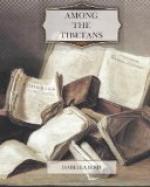Passing along faces of precipices and over waterless plateaux of blazing red gravel—’waste places,’ truly—the journey was cheered by the meeting of red and yellow lamas in companies, each lama twirling his prayer-cylinder, abbots, and skushoks (the latter believed to be incarnations of Buddha) with many retainers, or gay groups of priestly students, intoning in harsh and high-pitched monotones, Aum mani padne hun. And so past fascinating monastic buildings, through crystal torrents rushing over red rock, through flaming ravines, on rock ledges by scaffolded paths, camping in the afternoons near friendly villages on oases of irrigated alluvium, and down the Wanla water by the steepest and narrowest cleft ever used for traffic, I reached the Indus, crossed it by a wooden bridge where its broad, fierce current is narrowed by rocks to a width of sixty-five feet, and entered Ladak proper. A picturesque fort guards the bridge, and there travellers inscribe their names and are reported to Leh. I camped at Khalsi, a mile higher, but returned to the bridge in the evening to sketch, if I could, the grim nudity and repulsive horror of the surrounding mountains, attended only by Usman Shah. A few months earlier, this ruffian was sent down from Leh with six other soldiers and an officer to guard the fort, where they became the terror of all who crossed the bridge by their outrageous levies of blackmail. My swashbuckler quarrelled with the officer over a disreputable affair, and one night stabbed him mortally, induced his six comrades to plunge their knives into the body, sewed it up in a blanket, and threw it into the Indus, which disgorged it a little lower down. The men were all arrested and marched to Srinagar, where Usman turned ‘king’s evidence.’




